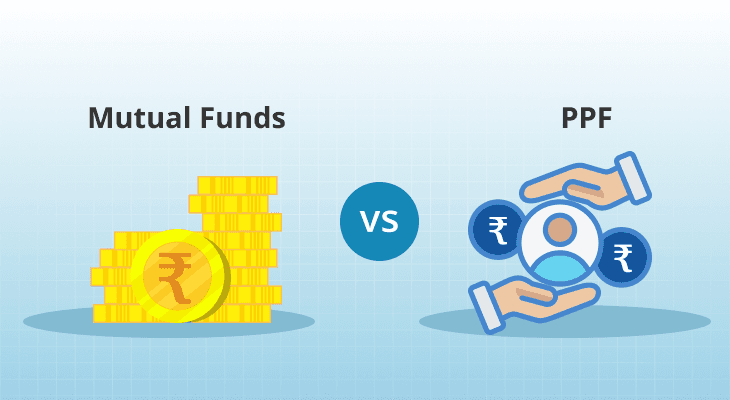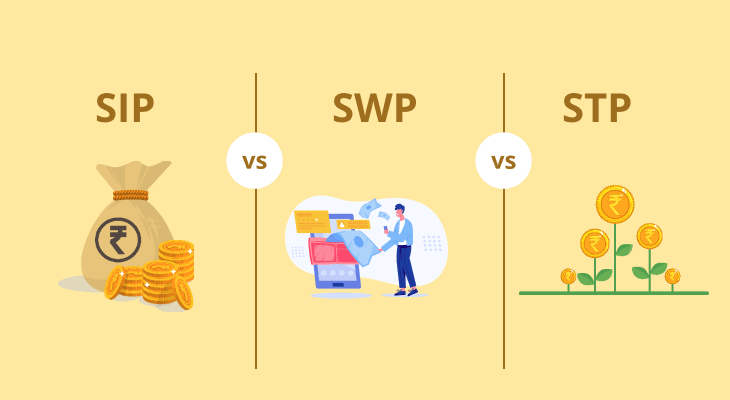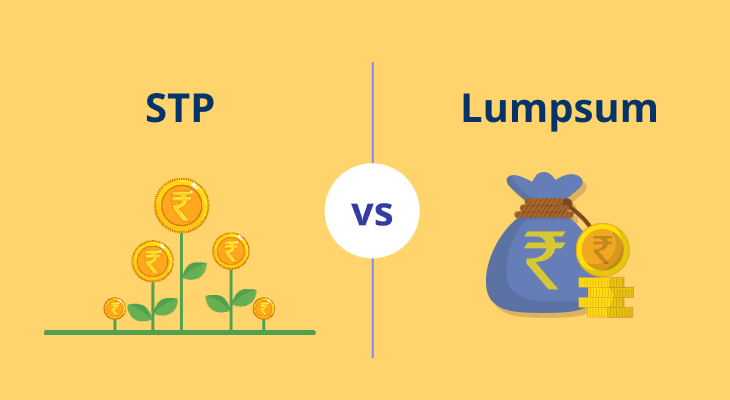
Mutual Funds vs PPF
Mutual Funds and the Public Provident Fund (PPF), have been the investment avenues of choice for a large number of Indians who seek to build wealth to meet their various financial goals. While both have their own sets of benefits and limitations, the mutual fund vs PPF debate tends to leave many investors confused. As you embark on your investment journey, the dilemma of choosing between the two is likely to take centre stage. Our in-depth exploration aims to break down the key differences between mutual funds and PPF, helping you make informed decisions tailored to your financial goals.
What are Mutual Funds?
Mutual Funds serve as collective investment instruments that pool funds from multiple investors to invest in diversified portfolios of stocks, bonds, or other assets. These funds are then professionally managed by experienced fund managers who strategically allocate the pooled capital. Mutual Funds offer you the opportunity to access a diverse range of investment avenues with varying risk profiles. These funds aim to generate returns for investors through capital appreciation, dividends, or interest income, aligning with individual financial goals and risk appetites.
How do they Work?
Investors purchase units in the Mutual Fund, and their returns are directly tied to the fund's performance. As the value of the underlying securities fluctuates, so does the Net Asset Value (NAV) of the Mutual Fund, reflecting the overall financial health of the investment.
What is PPF?
The Public Provident Fund (PPF) is a government-backed savings scheme aimed at creating long-term financial security for investors. Offering fixed returns and tax benefits, PPF allows you to invest a portion of your savings with the assurance of stable growth over time. With a lock-in period and attractive interest rates, PPF serves as a reliable avenue for building a retirement corpus and achieving long-term financial stability.
How does it Work?
PPF operates as a government-backed savings scheme with a fixed tenure. You can open a PPF account and contribute a fixed amount annually, enjoying the benefit of compounded interest over time. The government sets the interest rates, and the returns are tax-free. PPF comes with a mandatory lock-in period, ensuring that individuals commit to a long-term savings plan. The accumulated amount, along with the interest earned, can be withdrawn upon maturity, providing a reliable avenue for disciplined savings and long-term financial growth.
Mutual Fund vs PPF: Unveiling the Distinctions
Nature Of Investment
A mutual fund involves investing in a professionally managed portfolio of stocks, bonds, or other securities, providing diversification and potential for higher returns. On the other hand, PPF operates as a government-backed savings scheme, offering fixed returns with a focus on stability and security.
Risk And Returns
Mutual Funds come with varying risk profiles based on the type (equity, debt, hybrid). While there is potential for higher returns, they are subject to market fluctuations. PPF, though, offers a stable and fixed return, ensuring principal protection. Returns are relatively lower but come with minimal risk as there is no market exposure.
Lock-In Period
Most Mutual Funds do not have a fixed lock-in period, providing liquidity for investors to buy or sell units as per their convenience. In contrast, PPF has a mandatory lock-in period of 15 years, offering a disciplined and long-term savings approach but not ideal to meet short-term goals.
Liquidity
Mutual Funds provide liquidity as investors can buy or sell units at the prevailing NAV, facilitating easy access to funds. In PPF, while partial withdrawals are allowed after the 7th year, complete withdrawal is permitted only after the 15-year maturity period.
Tax Treatment
Tax implications vary based on the type of Mutual Fund. Equity funds may have capital gains tax, while debt funds have different tax implications. PPF offers EEE (Exempt-Exempt-Exempt) tax status. Contributions, interest earned, and maturity amount are all tax-free. This is where PPF scores the highest.
Flexibility In Contributions
Mutual Fund allows flexibility in the amount and frequency of contributions, catering to individual financial capabilities. PPF :requires a fixed annual contribution within the prescribed limit, restricting flexibility.
Interest Rate Determination
Mutual Fund returns are influenced by market dynamics, fund manager decisions, and overall economic conditions. PPF interest rates are set by the government and remain fixed for a specific financial quarter.
Purpose And Goal Alignment
Mutual Funds are ideal for those seeking market-linked returns, growth, and willing to navigate market risks for potential higher returns. However, PPF is suited for conservative investors looking for stable returns, long-term savings, and tax benefits.
Systematic Investment Plans (SIP) Vs Fixed Contributions
Mutual Funds allow investors to opt for SIP, enabling periodic investments. Moreover, they offer high flexibility in adjusting SIP amounts. PPF requires fixed annual contributions, limiting the scope for adjustments based on changing financial situations.
Accessibility
Mutual Funds are easily accessible through various platforms, including online portals, making transactions quick and convenient. PPF operates through designated banks and post offices, often requiring physical presence for account management and other activities.
Mutual Fund vs PPF: What’s Right For You?
Choosing between Mutual Funds and PPF depends on individual financial objectives, risk appetite, and investment horizon. While Mutual Funds offer dynamic market participation, PPF provides stability and security. Evaluating these factors ensures alignment with personal financial goals and strategies. You can use this table as reference to finetune your choice and align it with our financial goals.
| Parameters | Mutual Funds | PPF |
|---|---|---|
| Nature of Investment | Professionally managed portfolio of securities | Government-backed savings scheme |
| Risk and Returns | Varies based on type, potential for higher returns | Stable, fixed returns with minimal risk |
| Lock-in Period | Generally no fixed lock-in period | Mandatory 15-year lock-in period |
| Liquidity | High liquidity, units can be bought/sold as needed | Partial withdrawals allowed after 7 years, complete withdrawal after 15 years |
| Tax Treatment | Tax implications based on type of Mutual Fund | EEE tax status - contributions, interest, and maturity amount are tax-free |
| Flexibility in Contributions | Flexible in amount and frequency | Fixed annual contributions with prescribed limit |
| Interest Rate Determination | Influenced by market conditions, fund manager decisions | Fixed interest rates set by the government |
| Purpose and Goal Alignment | Suited for those seeking market-linked returns | Ideal for conservative investors, long-term savings, and tax benefits |
| SIP vs Fixed Contributions | Allows SIP with flexibility in amounts | Requires fixed annual contributions |
| Accessibility | Easily accessible through various platforms | Operates through designated banks/post offices, physical presence needed |
A large number of investors are gravitated towards PPF due to the tax benefit it offers. However, they end up missing out on the potential gains that mutual funds can provide by capitalising on the booming Indian markets. What if we told you that there’s an option that can give you the best of both worlds? Too good to be true?
ELSS: The Perfect Blend
Equity Linked Savings Schemes (ELSS) stand as a unique category within Mutual Funds, combining the wealth-building potential of equities with the tax benefits similar to Public Provident Fund (PPF). ELSS not only offers investors the opportunity for potentially higher returns by investing primarily in equities but also provides tax benefits (up to ₹ 1.5 Lakhs per annum) under Section 80C of the Income Tax Act.
With a mandatory lock-in period of only three years (as compared to 15 in PPF), ELSS blends the flexibility of Mutual Funds with the tax efficiency of PPF, making it an attractive choice for those seeking tax-saving avenues coupled with market-linked growth. Investors can leverage ELSS to strike a balance between wealth creation and tax-saving objectives within a single investment instrument.
SIPs let you invest small amounts regularly, making it easier to stay consistent with your goals. With time, your money grows faster through compounding, helping you get the most out of your investments. Try our SIP Calculator to see how your money can grow and make smarter plans for your future.
FAQ
Is PPF better than mutual funds?
The choice between PPF and Mutual Funds depends on individual financial goals. PPF offers tax benefits and stable returns, while Mutual Funds provide potential for higher returns with associated market risks.
What role does the lock-in period play in these investments?
Mutual Funds generally have no fixed lock-in period, providing liquidity, while PPF has a mandatory 15-year lock-in period for disciplined savings.
Can we use SIP for PPF?
No, SIP is not applicable to PPF. PPF involves fixed annual investments, and the SIP concept is primarily associated with Mutual Funds or exchange-traded funds (ETFs).
Can I claim ELSS and PPF together?
Yes, you can claim deductions under Section 80C for investments in both Equity Linked Savings Schemes (ELSS) and PPF, subject to the overall limit of ₹ 1.5 Lakhs.
Can one access funds easily in Mutual Funds compared to PPF?
Mutual Funds offer high liquidity, allowing investors to buy or sell units as needed, while PPF permits partial withdrawals after the 7th year.
Which investment option is more accessible for investors?
Mutual Funds are easily accessible through various platforms, including online portals, while PPF operates through designated banks and post offices.
Can ELSS be redeemed before the completion of the lock-in period in case of an emergency?
No, ELSS funds cannot be redeemed before the completion of the three-year lock-in period, ensuring that investors adhere to the specified tenure for tax benefits.
How is the tax treatment different for Mutual Funds and PPF?
Tax implications in Mutual Funds depend on the type, while PPF enjoys EEE tax status, making contributions, interest, and maturity amounts tax-free.
What factors should one consider when deciding between Mutual Funds and PPF?
Consider factors such as risk tolerance, investment goals, and liquidity needs. Mutual Funds suit those seeking market-linked returns, while PPF is ideal for stability and tax benefits.


